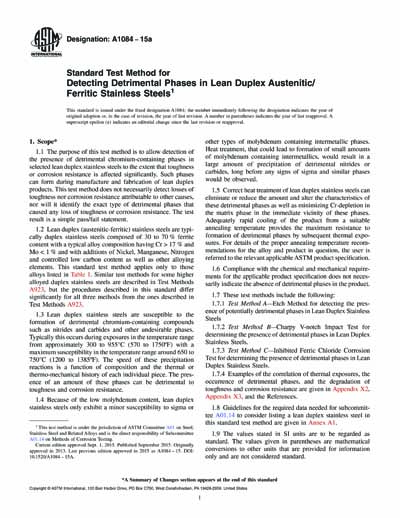Historical
ASTM A1084-15a
Standard Test Method for Detecting Detrimental Phases in Lean Duplex Austenitic/Ferritic Stainless Steels
1.1 The purpose of this test method is to allow detection of the presence of detrimental chromium-containing phases in selected lean duplex stainless steels to the extent that toughness or corrosion resistance is affected significantly. Such phases can form during manufacture and fabrication of lean duplex products. This test method does not necessarily detect losses of toughness nor corrosion resistance attributable to other causes, nor will it identify the exact type of detrimental phases that caused any loss of toughness or corrosion resistance. The test result is a simple pass/fail statement.
1.2 Lean duplex (austenitic-ferritic) stainless steels are typically duplex stainless steels composed of 30 to 70 % ferrite content with a typical alloy composition having Cr > 17 % and Mo < 1 % and with additions of Nickel, Manganese, Nitrogen and controlled low carbon content as well as other alloying elements. This standard test method applies only to those alloys listed in Table 1. Similar test methods for some higher alloyed duplex stainless steels are described in Test Methods A923, but the procedures described in this standard differ significantly for all three methods from the ones described in Test Methods A923.
1.3 Lean duplex stainless steels are susceptible to the formation of detrimental chromium-containing compounds such as nitrides and carbides and other undesirable phases. Typically this occurs during exposures in the temperature range from approximately 300 to 955°C (570 to 1750ºF) with a maximum susceptibility in the temperature range around 650 to 750°C (1200 to 1385ºF). The speed of these precipitation reactions is a function of composition and the thermal or thermo-mechanical history of each individual piece. The presence of an amount of these phases can be detrimental to toughness and corrosion resistance.
1.4 Because of the low molybdenum content, lean duplex stainless steels only exhibit a minor susceptibility to sigma or other types of molybdenum containing intermetallic phases. Heat treatment, that could lead to formation of small amounts of molybdenum containing intermetallics, would result in a large amount of precipitation of detrimental nitrides or carbides, long before any signs of sigma and similar phases would be observed.
Content Provider
ASTM International [astm]






